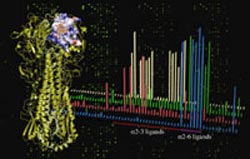New technique for detecting ability of flu viruses to infect humans

WHAT:
NIH-funded scientists at The Scripps Research Institute have developed a technique for detecting changes in flu viruses that would precede a virus’s ability to infect humans and cause epidemics. The new, publicly available tool, called a glycan array, could be used to monitor the emergence of flu strains that efficiently infect humans, including those of avian origin. The technology was developed by the Consortium for Functional Glycomics, a “glue grant” project sponsored by NIH’s National Institute of General Medical Sciences (NIGMS). The National Institute of Allergy and Infectious Diseases also funded the research.
WHY and WHEN:
“Glycoarray Analysis of the Hemagglutinins from Modern and Pandemic Influenza Viruses Reveals Different Receptor Specificities” by Ian Wilson, D.Phil., James Paulson, Ph.D., and their coworkers is scheduled to be published in the February 3, 2006 issue of the Journal of Molecular Biology. The article appeared online on November 18, 2005.
WHO:
Jeremy M. Berg, Ph.D., Director, National Institute of General Medical Sciences, is available to comment on the new technique and how it can be used to detect potentially dangerous flu strains. Berg can also discuss the NIGMS “glue grant” program, which brings together teams of scientists with diverse expertise to tackle complex problems that are of central importance to biomedical science.
Media Contact
All latest news from the category: Life Sciences and Chemistry
Articles and reports from the Life Sciences and chemistry area deal with applied and basic research into modern biology, chemistry and human medicine.
Valuable information can be found on a range of life sciences fields including bacteriology, biochemistry, bionics, bioinformatics, biophysics, biotechnology, genetics, geobotany, human biology, marine biology, microbiology, molecular biology, cellular biology, zoology, bioinorganic chemistry, microchemistry and environmental chemistry.
Newest articles

Sea slugs inspire highly stretchable biomedical sensor
USC Viterbi School of Engineering researcher Hangbo Zhao presents findings on highly stretchable and customizable microneedles for application in fields including neuroscience, tissue engineering, and wearable bioelectronics. The revolution in…

Twisting and binding matter waves with photons in a cavity
Precisely measuring the energy states of individual atoms has been a historical challenge for physicists due to atomic recoil. When an atom interacts with a photon, the atom “recoils” in…

Nanotubes, nanoparticles, and antibodies detect tiny amounts of fentanyl
New sensor is six orders of magnitude more sensitive than the next best thing. A research team at Pitt led by Alexander Star, a chemistry professor in the Kenneth P. Dietrich…





















